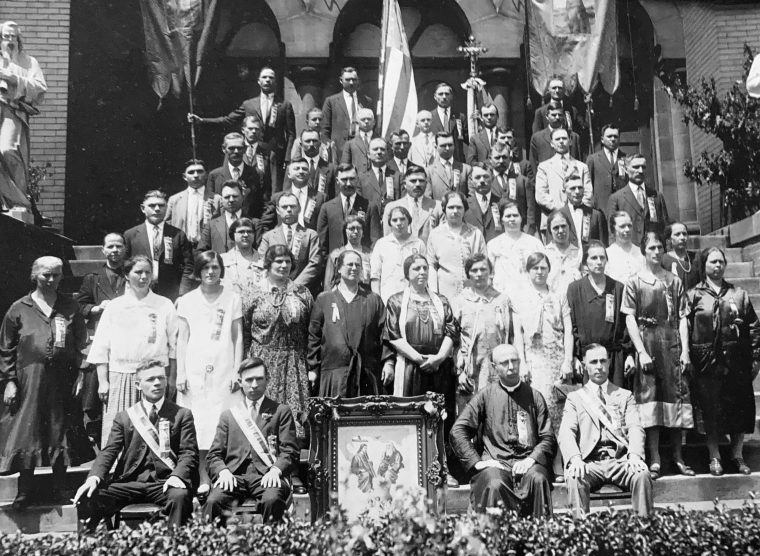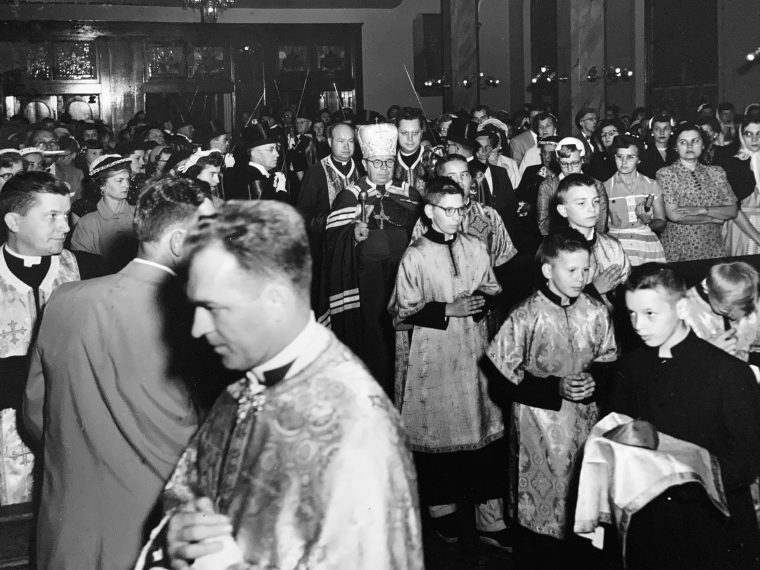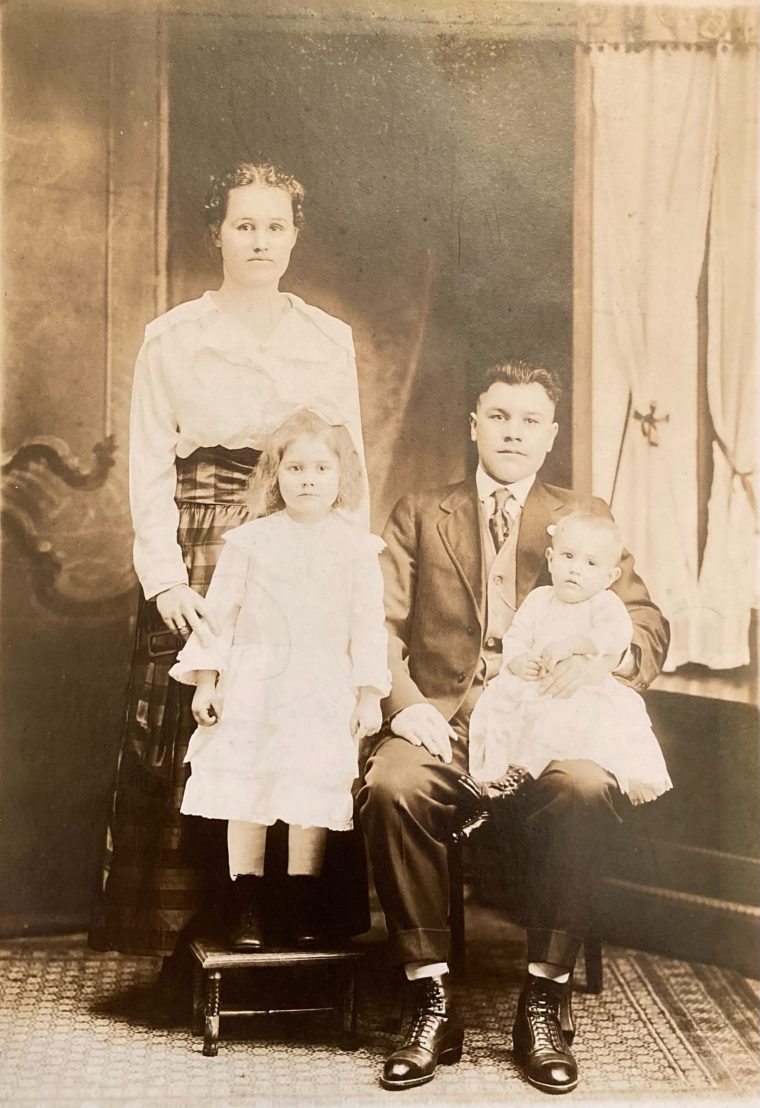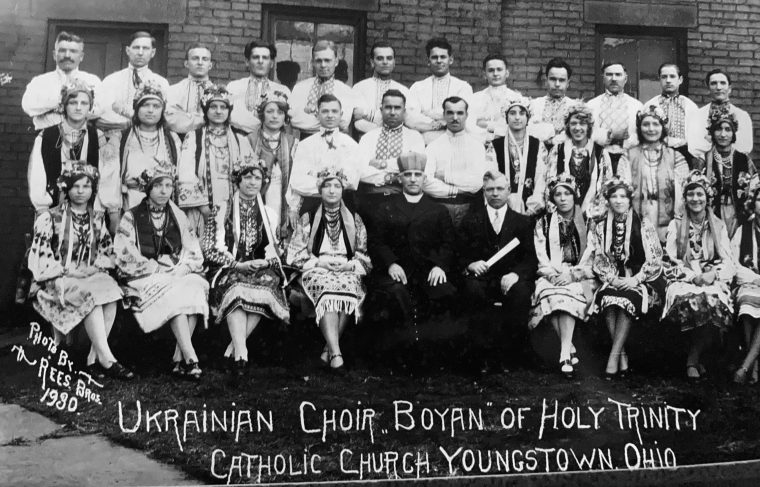Ten years before Russian tanks rolled across the Ukrainian frontier, 93-year-old area resident Harry Nachim shared his impressions of the bustling neighborhood that once surrounded Holy Trinity Ukrainian Catholic Church in Youngstown’s Arlington Heights District.
Nachim, a retired steelworker and World War II veteran, described solemn religious ceremonies and raucous political rallies, while chronicling the spirit of cooperation that bound together a neighborhood which reflected the city’s ethnic and racial diversity.
The interview, which occurred on Feb. 10, 2012, was planned as part of a larger oral-history project encouraged by the Ethnic Heritage Society, an organization then headquartered at Holy Apostles—Sts. Peter and Paul Roman Catholic Church, just a block north of Holy Trinity.
Two days after my conversation with Harry Nachim, however, I was swept up in a family tragedy that forced me to abandon the project. Hence, a recording of the interview sat, undisturbed, in a business envelope for the next decade.
Then, on the heels of Russia’s invasion of Ukraine in late February, Mark C. Peyko, editor of the Metro Monthly, contacted me with an unexpected request for any information that I might have on the local Ukrainian-American community. My mind turned instantly to that long-ago interview.
While Harry Nachim passed away in April 2017, I was pleased to learn that his wife, Charlotte, 10 years his junior, is alive and well. What follows is a brief overview of her late husband’s impressions of a district once known as Youngstown’s “West End.”


Today, little remains of the neighborhood he described, beyond a clutch of Catholic and Baptist churches, each of which served as the centerpiece of a densely populated residential area.
Like most good storytellers, Nachim started at the beginning. He explained that his father, Nicholas “Nick” Nachim, was born in 1893, in the tiny village of Lipa, which was then located in the sprawling Austro-Hungarian Empire. The elder Nachim’s journey to America was facilitated by his own father, who had left for New York in search of greater opportunities.
Harry Nachim indicated that his mother, Mary Kozak, was also born in Lipa, in 1895. Yet, his parents did not meet until the early 1910s, when they worked together at the American Linen Mills in Fulton, N.Y. Nicholas’s labor yielded a paltry 10 cents an hour; Mary earned even less.
After a brief courtship, the couple was married in Syracuse, N.Y., in 1914. Two years later, after the birth of their eldest child, Anne, they were briefly separated when Nick set out to search for better prospects. “My dad heard about Youngstown steel, where they were making 27 cents an hour,” Harry Nachim observed. “So, that was a big raise…and he said, ‘I’m leaving this joint.’”
The industrial boomtown Nick Nachim encountered hosted a growing Ukrainian-American community. Since the arrival of the area’s first Ukrainian immigrant in the late 1880s, the community had witnessed a flurry of institution building, including the establishment of Holy Trinity Ukrainian Catholic Church in 1909. The church edifice was completed two years later.
Nick Nachim quickly discovered that jobs were abundant. “The same day he came here, he got hired at Republic Steel in downtown Youngtown,” Harry Nachim said. “That’s the job he had till be retired [in 1962].”
By the time Harry Nachim was born in December 1918, his mother, father, and older sister were living in a rowhouse on the eastern end of downtown Youngstown, an immigrant enclave studded with low-end businesses. “[They had] everything…from clothing stores to raincoat [manufacturers] to pawnshops,” he recalled. “You would even find that they had an Isaly’s dairy store. So, you can see how far back that goes.”
In 1925, when Nachim was about six years old, his younger brother, Ted, was born, and the family began to look around for more spacious lodgings. They eventually settled in an apartment in the brick hall that still stands across the street from Holy Trinity. The structure, which currently serves as Holy Trinity’s parish social hall, was then owned by a Ukrainian-American mutual aid society called Narodna Dopomoho (“People’s Aid”).
The social hall was a landmark in what had become a thriving ethnic neighborhood. “They had a cluster of houses right next to the hall, on the lefthand side, facing the hall,” Nachim observed. “They had mostly Ukrainian families [living there]…. They all belonged to the church.” Intermixed with the district’s large Ukrainian-American population were dozens of Croatian-American families, most of whom worshipped at nearby Sts. Peter and Paul Roman Catholic Church.

The neighborhood’s multiethnic character notwithstanding, Nachim found plenty of evidence that pointed to its markedly different past. He indicated that West Rayen Avenue (now Martin Luther King, Jr., Boulevard) was lined with the aging mansions of the city’s old Anglo-American elite.
“At that time, it seems like…that neighborhood was converting,” he explained. “They had the original Youngstowners still living there.”
His nearest neighbors included once-prominent figures like J.W. Parkman, a retired transportation magnate whose carriages and teams of horses were maintained in stables that were located at the back of his property.
As a paperboy, Nachim occasionally entered the more impressive houses along his route, and he was especially drawn to a stately home at the corner of North Avenue and West Rayen Avenue. “When I went into the house, there was a portrait on the righthand side [of the vestibule], and…it stayed with my memory,” he said. “It looked like a Civil War officer, and he had to be highranking, with a portrait of that size.”
His curiosity was also aroused by the tumultuous politics of the era. Indeed, his family’s residence in the social hall gave him a front-row seat to the radical political movements that flourished in the late 1920s and early ’30s.
“There were a lot of political things going on there that…as a young boy, I didn’t quite understand,” he explained. In the summer of 1927, the inquisitive eight-year-old picked up a “Save Sacco and Vanzetti” button at an event organized to protest the imminent execution of two Italian-born anarchists who had been accused of killing a guard and paymaster during a 1920 robbery in Braintree, Mass.
Widespread perceptions that Nicolo Sacco and Bartolomeo Vanzetti had received an unfair trial because of their ethnic background and political beliefs transformed the case into an international cause célèbre. “I wish I had kept that button, which is valuable today,” Nachim observed, ruefully.
He pointed out that the fraternal organization that owned the hall made it available to any party willing to pay the rent. “They had the communists there,” Nachim recalled. “I’ll never forget it. The communists were organizing a trip to Washington [D.C.] for a protest. [in 1931]…. They were Black; they were white; they were all colors…. There was no discrimination…. I would say that there were so many of them [that] they were from Belmont [Avenue] almost to the hall, just lined up, trucks, cars, walking, [carrying] signs, singing.”
One of the songs the crowd sang as they departed for Washington was titled, “We’ll Hang Herbert Hoover on the Sour Apple Tree.” Other protesters sang the socialist anthem, “The Internationale.” “I liked that tune, but…that would be about it,” Nachim snapped.
Despite the era’s fractious political climate, the atmosphere of the Nachim family household was informed by their observance of religious traditions. “Our holidays were different than the Latin Rite,” he explained. “Jan. 7 was our Christmas, [and] we all had to go to church. What made it difficult for us…was explaining to the other children why it was Christmas. That was the tough part.”
Every Christmas Eve, the Nachim family would gather with a few Ukrainian-American neighbors for a 12-dish meatless dinner known as Sviata Vecheria. “What they would do [was], they would get straw and put it on the floor, like the manger at the birth of Christ,” Nachim recalled. “We’d have the feast that you were allowed to eat…. They had the nuts, all the puddings…and…the soup was made out of mushrooms.”
Afterward, the small group gathered to sing traditional Ukrainian Christmas carols, and one neighbor, a Mr. Forman, routinely broke out the “spirits.” “I thought he’d give me a sample, but he didn’t,” Nachim complained.
He stressed that commitments like religious tithing were maintained even during the hard years of the Great Depression. “They insisted on us, on Sunday, to give a dime [to the church],” Nachim noted. “All it took to go to a movie was 10 cents. I didn’t have that choice about what I was going to do with that dime. It was going to go to the church…. Forget about the movie.”
The youth also attended Sunday school at Holy Trinity, until he unwittingly angered the pastor, Father Vladimir Dowhovich. When another student hoisted a paper airplane during catechism class, Father Dowhovich mistakenly identified Nachim as the culprit. “Well, I never did that,” Nachim insisted. “So, the next thing you know, planes started flying again, and the class was disrupted.”
The pastor blamed Nachim for the episode and scheduled a meeting with his father. “So, my father said, ‘Expel him,’” he recalled. “Well, that was the worst thing he could have done, because I got my religious classes at home—and they were strict. But it was a case of the unwritten rule: ‘You don’t stool.’ I wouldn’t tell on who’d done it…so I took the blame.”
Later, he received catechism lessons from another pastor, Father John Zabawa, who feigned ignorance and asked for the boy’s assistance when writing about religious topics. “He’d come over to me and say: ‘Harry, I need help…. My writing is bad…. I’ll tell you about it, and you write it for me,’” Nachim explained. “Well, it was often, so he was testing me that way…. I knew it.” After providing a series of acceptable written responses, Nachim received the Sacrament of Confession. The following Sunday, Father Zabawa gave him Holy Communion.”
By the early 1930s, members of Nachim’s extended family had relocated to Youngstown, and he met with them after weekly religious services. “It seemed like when they came to church, they all visited together,” he recalled. “It was interesting, because they all talked about their homeland.”
Their conversations often focused on the draconian policies of the Soviet Union. “Most of them were talking about the famine in Russia…and they were saying how awful it was,” he observed. “Most of them…were from the Polish side [of the border]. The Ukrainians were dominated by the Polish, politically…and they lived there [in Poland], and they said: ‘It’s a good thing that our family lives there. They’re not affected by the famine.”
The origins of the famine struck them as mysterious. “Now, why should they have a famine?” Nachim asked. “They couldn’t understand why…the breadbasket of Europe—Ukraine, itself—why should they have a famine there, of all places…when you have the richest soil, and it’s black and it’s fertile…. They couldn’t understand it. Then, they discovered it was manmade.”
Indeed, since 2008, the Holodomor, or “Terror-Famine,” which killed millions of ethnic Ukrainians between 1932 and 1933, has been recognized by more than a dozen nations as a catastrophe precipitated by the Soviet government’s confiscation of food supplies, restriction of population movement, and rejection of outside assistance.
While Nachim and his relatives may have counted their blessings, life was often difficult during the dark years of the Depression. He noted that a local grocer, William “Willy” Wilkoff, who extended credit to his customers, “kept that neighborhood alive during the Depression.”
Still, one Croatian-American neighbor was practically reduced to begging for bread. “He was a bachelor at the time, wasn’t working,” he stated. “I took over some soup we had left over…and when I took it over to him, he said, ‘Harry, Harry, I want kruhovi.’ Kruhovi is bread in Yugoslavian. So, I went home, and I said: ‘Mom, Vlatko wants bread. He’s hungry.’ She took what bread we had and cut it up and said, ‘Take it….’ How they [did] it was, everybody helped each other, in any way they could.”
During our long conversation, Harry Nachim discussed a range of topics. He described the excitement that attended “Ukrainian Day” at Idora Park, one of the few times of the year that local Ukrainian-Americans of various religious backgrounds got together.
He conveyed his feelings of accomplishment when he landed his first job at the Isaly’s dairy store on Youngstown’s Central Square, adding that his experiences there opened up a whole new culinary world. No less memorable to him was the celebrity he enjoyed after being held up at gunpoint at the Isaly’s store and getting his name in the Vindicator.
Drafted into the U.S. military during peacetime, Nachim found himself guarding the Panama Canal and battling the intense heat. Four months after the Japanese attack on Pearl Harbor, which devastated America’s Pacific fleet, he witnessed something that he would never forget. “I saw the entire Atlantic fleet go through the canal to go to the Pacific—battle wagons, which I’d never seen before…like, destroyers, cruisers, air-craft carriers that took up to two days to go through the canal…after Pearl Harbor.”
Hesitant to discuss his combat experiences in North Africa and Italy, Nachim became more animated when the conversation turned to his years at Youngstown Sheet & Tube, which he evidently enjoyed. “I ended up as a millwright, and also an electrician and a pipefitter,” he recalled. “I took all the courses that were given free. So, I always felt that the Great Depression was going to happen again. The more I knew, the better off I was.”
He went on to describe his first meeting with future wife Charlotte Bielak on the floor of Canfield’s Parkview dancehall. Nachim recalled that the petite Polish-American from New Castle, Pa., was initially underwhelmed. “She didn’t like me,” he said. That situation had apparently changed by 1958, when the couple was married by Monsignor Leo Adamiak in a simple ceremony at Holy Trinity Ukrainian Catholic Church.
Most of all, however, Harry Nachim recalled the sacrifices that members of his community made to enhance the lives of others. When asked about his enduring commitment to Holy Trinity, he pointed out that he was one of the few people living who was personally acquainted with the church’s founding members.
He was especially close to Walter Sawchak, who donated the funds for Holy Trinity’s massive bell, which required two people to ring. “Every once in a while, one [person] wouldn’t show up, so Walter…would come and say, ‘Harry, come and help me,’” Nachim explained. “I used to go and ring that bell, not knowing that he paid for it…. He worked in the same mill my dad worked in. For what he made every day, that was a huge fortune…to buy that bell.”
***
Metro Monthly is a local news and events magazine based in Youngstown, Ohio. We circulate throughout the Mahoning Valley and offer print and online editions. Be sure to visit our publication’s website for news, features and the Metro Monthly Calendar. Office: 330-259-0435.
© 2022 Metro Monthly. All rights reserved.





